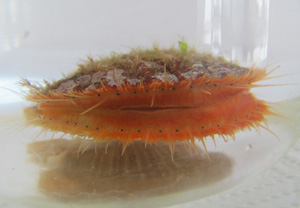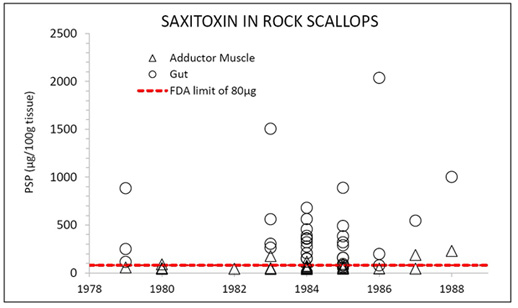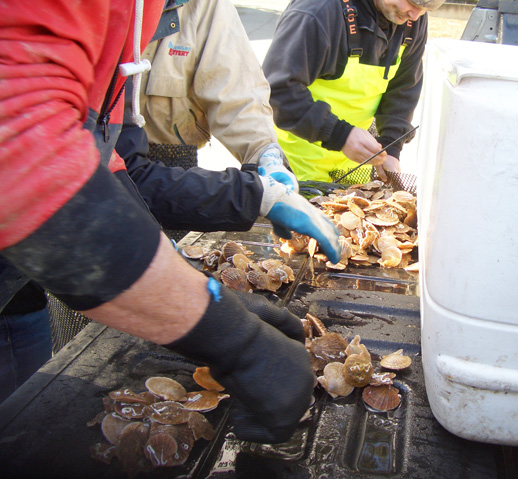|
Among the list of prospective new species for aquaculture, the purple hinged rock scallop is especially of interest. Due to the native species expansive range, culture could exist from Baja California to southeastern Alaska. Rock scallops grow rapidly in the first several years, achieving market size in 2-4 years. Live rock scallops have high market value, priced $5-$8/lb in California, and a potentially high value in the sushi market. Scallop farming has the potential to provide significant employment opportunities and to produce a high quality shellfish product for both domestic and export markets. However, one serious unresolved issue is the rock scallops’ propensity to ingest and retain toxins that can cause Paralytic Shellfish Poisoning (PSP) in humans. While previously collected data shows low levels of toxins in the scallops’ adductor muscle (marketable product) compared to the gut (Figure 1), more thorough research and monitoring is required.

The primary focus of this project is to address whether rock scallops are particularly susceptible to ingestion and retention of toxins produced by dinoflagellates. Our team will assess rock scallop uptake, tissue concentration and depuration trends of phycotoxins associated with the commonly occurring dinoflagellate, Alexandrium catenella under controlled lab and natural, field conditions. Through these experiments we will determine potential impacts on the developing aquaculture effort for this species. The results of the proposed research will assist public health agencies (specifically from California, Alaska, Oregon, and Washington) regarding biotoxin accumulation and depuration, informing Harvest Site Certification for rock scallop aquaculture. The research directly supports production of rock scallop by facilitating public health certification to allow sales in domestic and international markets. Furthermore, this research will enable public health labs in Washington and Alaska to evaluate the most appropriate biotoxin detection methods for this species.

Figure 1. Saxitoxin levels in WA collected rock scallops. The data suggests that PSP toxins accumulate less in the adductor muscle than in the gut. Data source: WDOH
Team Leaders: Bobbi Hudson (PI) from Pacific Shellfish Institute, and the following Co-PI’s: Dan Cheney (PSI) Joth Davis (Pacific Hybreed), Sandra Shumway (UCONN), Steve Morton (NOAA/NOS), Jerry Borchet (WDOH), Brent Vadopalas (UW). Funding for this project comes from the NOAA Sea Grant Aquaculture Research grant no. 2606753.
Project Partners:
Project Summary (printable 1-pg PDF)
Final Report 2021 (PDF)

Our team outplanted juvenile scallops to three sentinel mussel sites in Sequim Bay, WA in February 2017 for grow out and PSP monitoring.
| |
Houle, K. C., Bill, B. D., Christy, A., Davis, J. P., Leighfield, T. A., Morton, S. L., Shumway, S. E., Trainer, V. L., Vadopalas, B. & Hudson, B. 2023. Biotoxin Uptake, Retention, and Depuration Trends in Purple-Hinged Rock Scallops, Crassadoma gigantea (Gray 1825). Journal of Shellfish Research 42(2):265-279.
Internal anatomy of the purple hinged rock scallop, Crassadoma gigantea.
Juvenile rock scallops settled on marine algae (Photo: Joth Davis)
Juvenile scallop outplants in Sequim Bay, WA.
|
|













